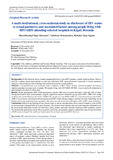| dc.contributor.author | Mashora, M. C. | |
| dc.contributor.author | Dzinamarira, T. | |
| dc.contributor.author | Ngomi, Nicholas N. | |
| dc.date.accessioned | 2021-03-24T12:09:37Z | |
| dc.date.available | 2021-03-24T12:09:37Z | |
| dc.date.issued | 2020-02 | |
| dc.identifier.citation | nternational Journal of Community Medicine and Public Health Mashora MC et al. Int J Community Med Public Health. 2020 Feb;7(2):399-405 http://www.ijcmph.com pISSN | en_US |
| dc.identifier.issn | 394-6040 | |
| dc.identifier.uri | https://www.ijcmph.com/index.php/ijcmph/article/view/5740 | |
| dc.identifier.uri | https://www.ijcmph.com/index.php/ijcmph/article/viewFile/5740/3690 | |
| dc.identifier.uri | https://www.researchgate.net/publication/338906155_A_multi-institutional_cross-sectional_study_on_disclosure_of_HIV_status_to_sexual_partners_and_associated_factors_among_people_living_with_HIVAIDS_attending_selected_hospitals_in_Kigali_Rwanda | |
| dc.identifier.uri | http://hdl.handle.net/123456789/4557 | |
| dc.description | DOI: http://dx.doi.org/10.18203/2394-6040.ijcmph20200405 | en_US |
| dc.description.abstract | Background: In Sub-Saharan Africa, human immunodeficiency virus (HIV) remains a public health problem. There is need for evidence-based interventions to curb new infections. HIV status disclosure, especially to sexual partner(s) remains a critical step towards reducing viral transmission across sexual partners.
Methods: A hospital-based cross-sectional study, conducted at HIV clinics of three selected hospitals. Systematic random sampling was employed to sample 384 people living with HIV/AIDS (PLWH). A pre-tested self-administered questionnaire was used to collect data.
Results: Of the participants, 66% of the participants reported HIV positive status disclosure, with only 46% of these having disclosed to their sexual partner. Logistic regression analysis identified age (p value 0.035; AOR 0.94), being satisfied with counselling (p value 0.017; AOR 0.24), gender (p value 0.030; AOR 5.51) and education (p value 0.041; AOR 2.14) as factors associated with having disclosed HIV status. Being younger, satisfaction with counselling, being female and having attained at least secondary education were all associated with higher odds of HIV status disclosure.
Conclusions: Based on the findings of the current study, it can be concluded that there is need to improve rates of HIV status disclosure among PLWH in Kigali, Rwanda. The current study findings have provided baseline information for the local health authorities, health care providers, policy makers and other scholars working in HIV epidemic control. The local health authorities can use this as a guide to develop a programme aimed to address the issue of non-disclosure of HIV status in Kigali City and hence help control the incessant spread of HIV infection. | en_US |
| dc.language.iso | en | en_US |
| dc.subject | HIV status disclosure, Sexual partner, Rwanda | en_US |
| dc.title | A multi-institutional, cross-sectional study on disclosure of HIV status to sexual partner(s) and associated factors among people living with HIV/AIDS attending selected hospitals in Kigali, Rwanda | en_US |
| dc.type | Article | en_US |

